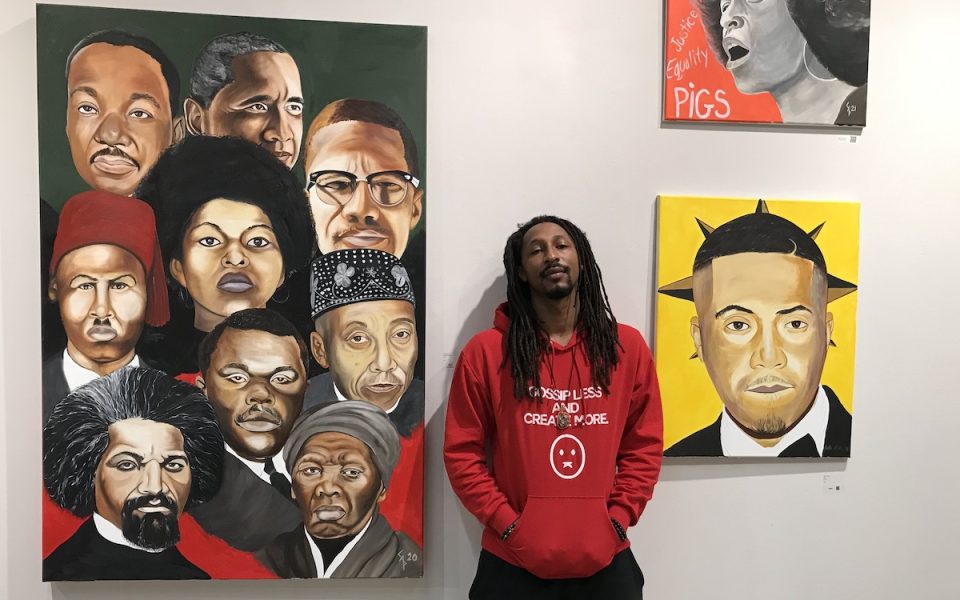Featured photo: Terence Walker curated “SOULiloquies” an interactive art exhibit that celebrates Black legends at the CVA. (photo by Michaela Ratliff)
When Terence Walker views “Contact”— a painting by Dwayne Howell — it’s like looking in a mirror.
“That was me a month ago,” he says, the day his daughter Sakina was born: Jan. 25.
In the image, a man cradles his newborn’s head as the child reaches back at him. His gaze is defined by a yellow ray of light extending from his left eye that surrounds the baby’s head. Viewers can’t help but be drawn to the light as it stands out against the muted tones of blue and gray that define the man. The ray seems to represent knowledge the man intends to pass on to his child or how the child metaphorically is the light of his life.
“Contact” is one of the many pieces of art featured in SOULiloquies: Stories of Underground Legends, an interactive exhibit at the Center for Visual Artists in Greensboro curated by Walker that opened on Feb. 5. Each piece in the exhibit features a corresponding QR code next to it that allows visitors to view further information that relates to each piece.

Using his background in music, Walker says that he wanted to extend the reach of his latest album, 4 the Record, by expressing it in the form of paintings and stories.
Walker has been rapping for over a decade, specializing in conscious hip-hop, a subgenre dense with political messages and themes. With his music, he aims to bring awareness to the plight of the Black community, racism and other issues. In 2016, he released his album Strictly4MyNegus, followed by Strictly4MyNegus Act II: United States of Affliction in 2017. The next album was supposed to be called SOULiloquies: Stories of Underground Legends.
“Initially I just wanted to highlight my grandparents and talk about the underground legends in my life,” he says.
Things changed.
During a car ride to a workshop held at NC A&T State University with New Orleans poet Sunni Patterson, she offered him positive feedback on the albums. She also dropped knowledge of New Orleans’ history and influential Black figures, sparking an idea in Walker.
“I was like, Damn, I gotta get the history of all these other underground legends we don’t know,” he says.
He contacted close friends to create books, paintings and poetry to pay homage to the legends in the exhibit.
“I can take it beyond the music,” he says.
The artists were given no restrictions on their creations, dedicating their pieces to those they considered underground legends whether they were musicians, family or even friends.
The walls of the gallery are covered with portraits of hip-hop artists, political activists and local figures. A painting of Winston-Salem musician LB the Poet makes an appearance.
The “Homage to Hip-Hop” section of the exhibition is enhanced by the head-bopping, ’90s rap-influenced beats that play during the exhibit. Two chairs and a TV sit in the corner where viewers can relax and enjoy hip-hop influenced films such as Belly or Paid in Full. Howell’s Earth 718 series combines Black public figures like boxer Mike Tyson with Marvel heroes like the Hulk. The combination of the two figures mirrors and enhances the physical strength of each character. Although he appears green and muscular like the Hulk, the blue boxing shorts Tyson wears and the tribal tattoo on his face are instantly recognizable.
“Big Mama,” a painting by Greensboro artist Carlos Parks, features a matronly Black woman washing what appears to be her grandchild. It is unclear whether Big Mama is dipping or wringing out the washcloth she holds. She carries a slight smile on her face as she spends time with the child. According to Walker, a standout piece of the exhibit is “Nana’s Baptism,” a story written by Morgan Myers that coincides with “Big Mama.”
“As she tells the story, you get to see the image in motion,” he says. “She gives it life.”

Myers speaks as Nana in her story, telling a summarized version of her life to the baby she’s bathing. The sound of water dripping, a chair rocking and the muffled rustling of a towel being spread play in the background, infusing additional texture to the image.
From the music to the art to the stories featured in it, the apparent theme of Black excellence dominates the show. It features Black art by Black artists, with Walker aiming to remind Black people of their history, ancestors’ accomplishments and political activists’ feats. He stresses Black people should never stop seeking knowledge of the people that came before them.
“The more we learn about them, the more we learn about ourselves,” he says.
SOULiloquies: Stories of Underground Legends is on display at the Center for Visual Artists until April 5. To register for the exhibit, visit HeavyEnergyUniversity.com.
Join the First Amendment Society, a membership that goes directly to funding TCB‘s newsroom.
We believe that reporting can save the world.
The TCB First Amendment Society recognizes the vital role of a free, unfettered press with a bundling of local experiences designed to build community, and unique engagements with our newsroom that will help you understand, and shape, local journalism’s critical role in uplifting the people in our cities.
All revenue goes directly into the newsroom as reporters’ salaries and freelance commissions.


Leave a Reply